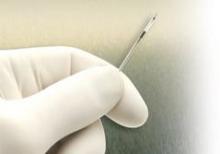SAN FRANCISCO – Lead pacing from inside the heart’s left ventricle – an alternate site compared with traditional implants – was successful in 89% of implant attempts, results from a multicenter study of 138 patients showed.
"The difficulty with conventional coronary sinus pacing is that we are limited by coronary sinus anatomy," Dr. John M. Morgan said in a press briefing at the annual scientific sessions of the Heart Rhythm Society. "But with the ability to get to inside the left ventricle, we have the landscape to choose the most appropriate pacing site. The reason that this outcome is important is that many patients who currently get cardiac pacing therapy do not benefit from it. About 10% of patients don’t get an implant because there is failure to achieve a pacing site with the conventional coronary sinus approach, and roughly one-third of patients, even when they have their implant, do not respond."
In a trial known as ALSYNC (Alternate Site Cardiac Resynchronization), Dr. Morgan and his associates at 18 centers in Europe and Canada investigated the safety and efficacy of left ventricular endocardial pacing using a Medtronic Model 3830 lead delivered using a novel transseptal system. The system is not currently available for investigational or commercial use in the United States.
The 138 study participants were indicated for cardiac resynchronization therapy (CRT) but were unable to receive a conventional system or did not respond to the therapy at least 6 months post implant. "This so-called nonresponder group has been steadily present over the last decade and a half in all of the evaluations of this otherwise valuable therapy," he said. "We believe that we may be able to address those issues by offering patients who are very sick with heart failure the benefit of cardiac resynchronization by placing the device inside the left ventricle."
The potential downside of this technique, he continued, "is that it’s perhaps slightly more technically challenging, so we need good tools to do that. The other downside is that there is a risk of perhaps developing blood clots in the left side of the heart because we’re putting tools into the left side of the heart, and therefore exposing the circulation to potential development of blood clots that can cause stroke. That has been a major concern for clinicians. The other issue is that, with this technology, we are putting a pacing lead across the mitral valve. There is a possibility that the mitral valve would in some way be impeded or interfered with by this pacing lead."


